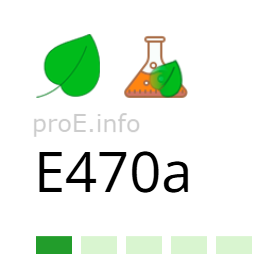
Other names for the additive (synonyms)
General Information
Additive E470a (sodium, potassium, and calcium salts of fatty acids) is a subtype of additive E470, which groups together food additives that are fatty acid salts.
The code E470a is used in accordance with EU Regulation (EC) No 1333/2008. In the international Codex Alimentarius standard "Class Names and the International Numbering System for Food Additives (CXG 36-1989)", it corresponds to two subcategories:
- INS 470(i) — salts of myristic, palmitic, and stearic acids with ammonium, calcium, potassium, and sodium;
- INS 470(ii) — salts of oleic acid with calcium, potassium, and sodium.
These substances are compounds obtained by reacting fatty acids with corresponding alkali or alkaline earth metals. The chemical formula depends on the specific cation: for example, sodium stearate has the formula C₁₇H₃₅COONa, potassium stearate — C₁₇H₃₅COOK, and calcium stearate — (C₁₇H₃₅COO)₂Ca.
Additive E470a is mainly produced from natural vegetable or animal fats and oils by saponification with sodium, potassium, or calcium hydroxides followed by purification. In industry, by-products of vegetable oil processing are often used to reduce costs.
Additive E470a appears as white or slightly creamy powders or granules without odor, insoluble in water but capable of forming dispersions. They possess pronounced emulsifying, anti-caking, and separating properties.
Compared to the subtype E470b (magnesium salts of fatty acids), additive E470a exhibits a stronger anti-caking effect and is more commonly used in dry food mixes as well as a texture improver in bakery and confectionery products. Meanwhile, additive E470b is more often used in pharmaceutical tablets and capsules due to its lubricating properties.
More detailed information on the health effects and legal status of additive E470a can be found in the main article about additive E470.